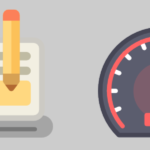5 Easy Ways to Speed up Your WordPress Website without Using a CDN
 Nobody likes slow websites. It’s a fact. They’re annoying and terrible for business. Thankfully, if you’re using WordPress, there are a few easy ways that you can speed up your page loading time without resorting to expensive and complicated CDN’s.
Nobody likes slow websites. It’s a fact. They’re annoying and terrible for business. Thankfully, if you’re using WordPress, there are a few easy ways that you can speed up your page loading time without resorting to expensive and complicated CDN’s.
WordPress performance means spending the time to solidify the fundamentals of web performance optimisation.
Should I use a CDN?
CDN (or Content Delivery Network) is a geographically distributed farm of caching servers that serve web content to web visitors depending on what geographic location they’re in.
For example, if your WordPress site has a fan base in Australia the visitors, it’s a heck of a lot faster to download your site’s data from a server in Australia versus the origin server. Which could be thousands of miles away. Sounds great, right?
In theory (and in practice) CDN’s are an excellent tool to help improve your websites performance. Using a CDN will most probably help your performance (if you use a good CDN).
But CDN is NOT required for a fast loading WordPress:
- Fix root issues first: Before even considering a CDN, try the 5 tips below. Walk before you run.
- Analyse your Demographics: Login to Google Analytics and take a look at your geographical profile. Are most your visitors near your origin server? If not, perhaps migrate your website to a hosting provider closer to your audience? CDN is best used in cases with a very diverse global audience
- Analyse your WordPress site’s payload: Is your site heavy on the media content? Large resolution photographs? Locally streamed video content? If not – then CDN might not really help that much. But if you are media heavy DEFINITELY learn more about the benefits of CDN for media streaming.
How to Speed up your WordPress without a CDN
Pay attention to these 5 simple tips, you can drastically improve your WordPress website’s performance without the need of a CDN.
Use an absolutely epic hosting provider
Ever heard of Pareto’s principle? It states that 20% of the inputs yield 80% of the outputs.
If you have to choose one thing out of this list, don’t screw this one up.
Choosing the right hosting provider is the single most important factor in how fast your WordPress site will host.
Here’s why choosing the right host is so important:
- Slow and unreliable hardware will invalidate anything else you do to help performance. This will waste your time and frustrate you immensely.
- If you choose Managed WordPress Hosting your host will help guide you through everything else on this list. This will save you time and satisfy you immensely.
Choosing the right hosting provider isn’t that easy nowadays. If you do a google search for “WordPress Hosting” half of the results on the first page are “review” sites that promote infamously unreliable hosting providers because their affiliate programs have great payouts.
You’ll see many so-called unbiased review sites promoting EIG brands like BlueHost, Hostgator, and iPage. It’s easy to get captivated by the thought of “Unlimited Resources” but you will regret it if your WordPress site ever gets the bitter-sweet pleasure of experiencing the slashdot effect.
Choose higher quality (but more obscure) managed wordpress hosting solutions from providers that have a strong track record. You want a hosting provider that offers real-time 24/7 support for advanced WordPress performance requests like “please help me configure Varnish Cache to prevent my backend wp-admin from being cached” or “please audit my MySQL configuration file – I think it has room for improvement.”
Compress your media and web assets
It’s amazing how often beginners upload massive .PNG images (sometimes +5MB!!) and then wonder why their WordPress is so slow. Yes, optimising your images before uploading is time consuming. It’s honestly a pain in the butt, but thankfully there’s an easier way.
Check out the free plugin called WP-SmushIt. This plugin optimises and compresses your images on the fly using lossless compression techniques. Perfect if you can’t be bothered to manually export all your images as “web safe” on Sketch or Photoshop.
In the same ballpark is minification of your CSS and JS files. Instead of loading many different CSS and JS files (happens all the time) — why not condense them all into a single file?
This is what minification does, and it works like a charm.
Use caching plugins
WordPress caching plugins are an easy way to boost your WordPress website’s performance without really having to think too much. Just download and activate the plugin, and the rest is generally a wizard style setup which is super easy.
There’s a few really good WordPress caching plugins available for free. Our favorite is W3 Total Cache as it’s got all the features you’ll ever need and is a breeze to get up and running. Doesn’t hurt that it’s got amazing reviews, and is recommended by everyone and anyone that matters in the WordPress community.
Gzip your web assets
GZIP compresses web assets like CSS and Javascript on the server and then sends them in compressed format to the browser. This places the burden on the browser (and consequently the local PC/Laptop) to unzip the payload.
Result?
Huge performance boost and up to 50-80% reduction in bandwidth for the compressed web assests.
There are loads of plugins that will setup GZIP for you, but if you can, do it manually. If you can’t, ask your hosting provider to add the following to your .htaccess file.
AddOutputFilterByType DEFLATE text/css
AddOutputFilterByType DEFLATE application/xml
AddOutputFilterByType DEFLATE application/xhtml+xml
AddOutputFilterByType DEFLATE application/rss+xml
AddOutputFilterByType DEFLATE application/javascript
AddOutputFilterByType DEFLATE application/x-javascript
AddOutputFilterByType DEFLATE text/plain
AddOutputFilterByType DEFLATE text/html
AddOutputFilterByType DEFLATE text/xml
Audit your plugins for bloat
There are thousands of awesome free plugins available for download. With just a few clicks, you can download, install, and activate a wide variety of plugins that can do magical things for you. But do you really need (or even use) all of these plugins?
We see it on a daily basis. Webmasters read a blog that review XYZ plugin which piques their interest and gets them to install it just to test it out. They then forget they have installed it and never remove it.
Why Plugin Bloat is NOT good!
- Slows down the site in most cases
- Increases surface vector of attack for hackers
- One more thing you’ll have to remember to constantly update in order to keep your system secure for known vulnerabilities
- Wastes space and clutters your WP dashboard
The easiest way to prevent WordPress Plugin Bloat is to simply not install a plugin unless you absolutely need it. And in the case you just have to install a plugin to test and try it out, set a reminder to remove it after 3 days if you’ve decided it’s not right for you.
Final Thoughts
How hard is it to speed up your WordPress site?
Judging from the rates that some WordPress web performance optimisation specialists charge, you’d think that improving the speed of your WordPress site is something that only expert developers can handle.
But judging from how easy the above speed hacks are, you don’t have to be a 10+ year veteran to optimise your WordPress site for performance. And in most cases, you don’t have to spend money on expensive and complicated CDN (although it does help in certain cases) setups either.
Improving the performance of your WordPress site really boils down to a few core things:
- Ensuring your Web Assets are Compressed
- Choosing the right hosting provider
- Caching. Caching.
- So Easy.
- Keeping your plugins in check.
If you do the above things – the odds are in your favor that your WordPress site will load faster than the baseline average.



